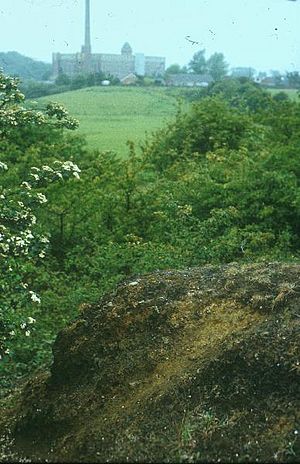Nob End facts for kids
Nob End is a special place in Greater Manchester, England. It's near the towns of Little Lever and Kearsley. Long ago, it was a place where factory waste was dumped. Today, it's a protected area. It is known as a Site of Special Scientific Interest and a Local Nature Reserve. This means it's important for its wildlife and plants.
History of Nob End
Nob End is located where two rivers meet: the River Irwell and the River Croal. Around the years 1850 to 1870, this site was used as a dumping ground. Factories produced a chemical called sodium carbonate, also known as soda ash. Making this chemical created a lot of toxic waste.
This waste was very alkaline, meaning it was the opposite of acidic. It was called 'galligu'. Galligu was a blue, slimy sludge. It contained a chemical called calcium sulphide, which made it smell like rotten eggs. Over many years, the surface of this waste changed. It turned into calcium carbonate, which is like limestone.
Because of this change, special plants started to grow there. These plants prefer soil that is rich in calcium. This type of grassland is rare in Greater Manchester. So, many of the plants found at Nob End are not common in the area.
Nob End became a Site of Special Scientific Interest (SSSI) in 1988. This protects the site because of its unique nature. In 2000, it also became a Local Nature Reserve. The site covers about 8.8 hectares, which is about 21.7 acres.
In 1936, a part of the Manchester Bolton & Bury Canal broke. This happened east of the Nob End locks. The canal was no longer used after this break. The damage was never fixed.
Habitats at Nob End
A habitat is a natural home or environment for plants and animals. Nob End has several different habitats. These habitats formed depending on the type of waste dumped there. They also depend on how the waste was spread out. The ground underneath also played a part.
Here are some of the habitats you can find:
- Open Grasslands: These areas have many different plant species. They are rich in plants that like calcium-rich soil.
- Fescue Grasslands: These grasslands grow with Willow bushes. Fescue is a type of grass.
- Wet Areas: Some parts of Nob End are wet. Here you can find rushes and other marsh plants. Willow bushes also grow in these damp spots.
- Neutral Grasslands: These areas have soil with a balanced soil pH level. This means the soil is neither very acidic nor very alkaline.
- Acid Grasslands: Other parts of the site have soil that is more acidic. Different types of plants grow well in these conditions.
Flora of Nob End
Flora refers to all the plants that grow in a particular area. Nob End is home to many interesting plant species. Because of its unique soil, some rare plants thrive here.
Some of the plants you might see include:
- Many types of beautiful Orchids.
- Broomrape, which is a plant that gets its food from other plants.
- Twayblade, a type of orchid with two large leaves.
- Blue fleabane, a plant with small, daisy-like flowers.
- Carline thistle, a prickly plant with golden-brown flowers.


